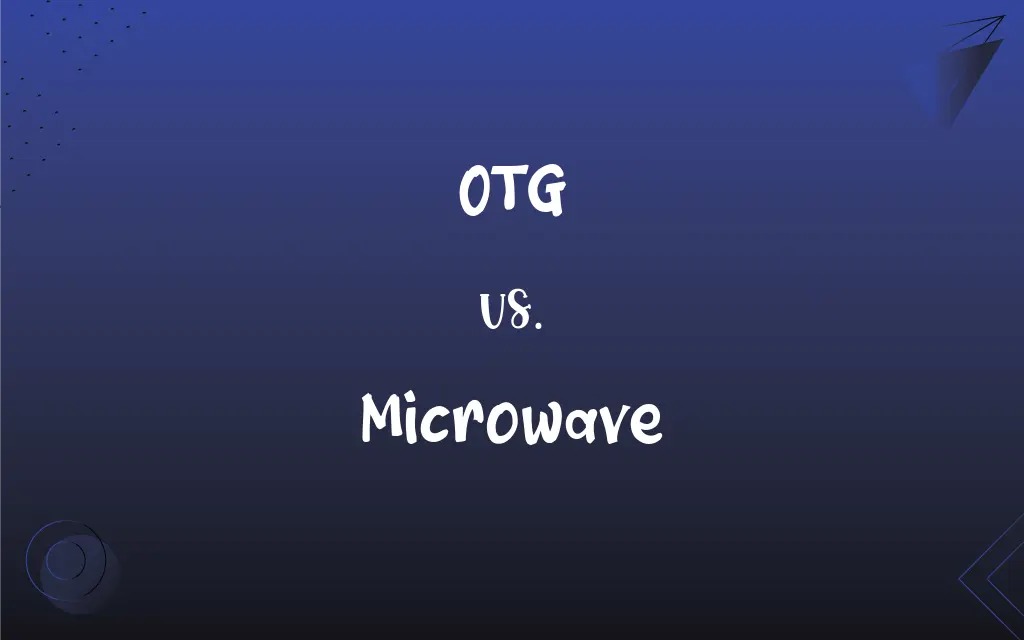OTG vs. Microwave: What's the Difference?
Edited by Janet White || By Harlon Moss || Updated on October 24, 2023
OTG (Oven Toaster Griller) bakes, grills, and toasts using heating elements; a microwave cooks using electromagnetic waves.

Key Differences
An OTG (Oven Toaster Griller) and a microwave are two popular kitchen appliances, each with unique functionalities. An OTG, as the name suggests, serves a tri-fold purpose: it can bake, toast, and grill. Utilizing heating elements located at the top and bottom, an OTG provides a conventional cooking experience, making it ideal for baking cakes or grilling meat. On the contrary, a microwave employs electromagnetic waves, which agitate water molecules in food, producing heat that cooks the food from the inside out.
Microwaves are lauded for their speed and efficiency. They can reheat leftovers, defrost frozen items, and even cook certain dishes remarkably quickly. This speed is a result of the microwave's method of directly heating the water molecules within food. OTGs, however, take a more extended period to preheat and cook, but they offer precise temperatures and even heat distribution, often preferred for specific recipes, especially baking.
The design of an OTG often mimics that of a mini conventional oven, with racks and a front-opening door. They also tend to have manual dials or digital controls to adjust temperature and cooking mode. Microwaves, however, come with a distinct design: a front-opening door with a turntable inside. They typically feature a digital control panel, offering various cooking settings and power levels.
To choose between an OTG and a microwave often boils down to the user's cooking needs. If one is keen on baking, roasting, and grilling, an OTG might be more suitable. Conversely, for those who prioritize speed and convenience, especially for reheating and simple cooking tasks, a microwave would be the preferable choice.
Comparison Chart
Functionality
Bakes, grills, and toasts
Cooks using electromagnetic waves
ADVERTISEMENT
Heating Method
Uses heating elements
Uses electromagnetic radiation
Design
Mini oven design with racks
Features a turntable with front-opening door
Cooking Time
Generally slower, needs preheating
Faster, especially for reheating
Primary Use
Baking, roasting, grilling
Reheating, defrosting, basic cooking
OTG and Microwave Definitions
OTG
Ideal for precise temperature cooking.
Using the OTG, he roasted the vegetables at a consistent 400°F.
ADVERTISEMENT
Microwave
Efficient for quick heating and defrosting.
He defrosted the chicken quickly using the microwave.
OTG
A kitchen appliance for baking, toasting, and grilling.
She baked the cake perfectly in the OTG.
Microwave
Comes with various power levels and settings.
I set the microwave to 50% power to melt the chocolate.
OTG
Utilizes heating elements for cooking.
The OTG's top element gave the chicken a crispy finish.
Microwave
Typically features a turntable for even heating.
Ensure the bowl is microwave-safe and place it on the turntable.
OTG
Provides even and consistent heat for cooking.
The bread toasted uniformly in the OTG.
Microwave
An appliance that cooks using electromagnetic waves.
She reheated her coffee in the microwave.
OTG
Often requires preheating before use.
Before baking cookies, preheat the OTG to 375°F.
Microwave
Operates by agitating water molecules in food.
The soup was piping hot after two minutes in the microwave.
Microwave
Relating to or being electromagnetic radiation between radio waves and infrared waves in the electromagnetic spectrum, having frequencies between 300 megahertz and 300 gigahertz and wavelengths between 1 meter and 1 millimeter.
FAQs
How does a microwave cook food?
A microwave uses electromagnetic waves to agitate water molecules in food, producing heat.
Is preheating necessary in an OTG?
Yes, most recipes require preheating the OTG for accurate cooking.
Can I bake a cake in a microwave?
While possible, it's preferable to use an OTG or convection microwave for best results.
Can metal utensils be used in a microwave?
No, metal utensils can cause arcing and damage the microwave.
What does OTG stand for?
OTG stands for Oven Toaster Griller.
Can I use glass containers in an OTG?
Only if they're oven-safe. Check the manufacturer's instructions.
Why can't metal containers be used in microwaves?
Metal reflects microwaves, causing arcing and potential damage.
Can I grill in a microwave?
Only if it has a grilling function; otherwise, an OTG is ideal for grilling.
Are there microwaves with baking functions?
Yes, these are known as convection microwaves.
Do OTGs consume more electricity than microwaves?
OTGs might consume more power due to extended cooking times compared to microwaves.
Can microwaves cook unevenly?
Yes, if not placed correctly on the turntable or if the microwave is overloaded.
Why does food sometimes become soggy in the microwave?
Microwaves cook by agitating water molecules, which can make certain foods soggy.
Do all microwaves have a turntable?
Most do, to ensure even heating of the food.
Why is there a rotating turntable in microwaves?
To ensure even cooking by exposing all parts of the food to the microwaves.
Can I use my microwave for baking?
Only if it's a convection microwave, which combines microwave and baking functions.
Which is better for crispy results: OTG or microwave?
OTG, as it uses dry heat which can crisp up food.
How do I clean my OTG?
Use a mixture of baking soda and water or a specific oven cleaner.
Is it safe to touch the inside of a hot OTG?
No, always use oven mitts or a cloth to avoid burns.
Which is faster: OTG or microwave?
Microwaves are generally faster, especially for reheating.
Can I bake bread in an OTG?
Yes, OTGs are excellent for baking bread.
About Author
Written by
Harlon MossHarlon is a seasoned quality moderator and accomplished content writer for Difference Wiki. An alumnus of the prestigious University of California, he earned his degree in Computer Science. Leveraging his academic background, Harlon brings a meticulous and informed perspective to his work, ensuring content accuracy and excellence.
Edited by
Janet WhiteJanet White has been an esteemed writer and blogger for Difference Wiki. Holding a Master's degree in Science and Medical Journalism from the prestigious Boston University, she has consistently demonstrated her expertise and passion for her field. When she's not immersed in her work, Janet relishes her time exercising, delving into a good book, and cherishing moments with friends and family.































































